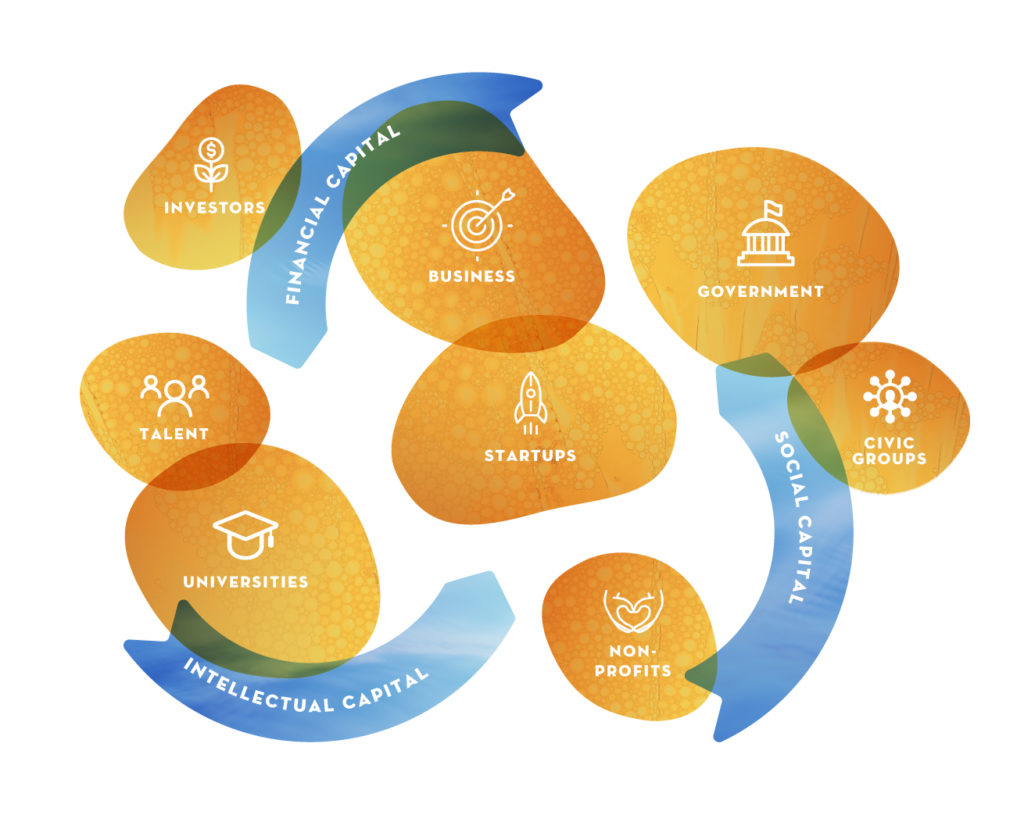An Introduction to Economic Vibrancy

I’m an entrepreneur, not an economist. But after a spectacular tour of duty in both industry and startup environments, I’ve grown fascinated with economic vibrancy and the role tech entrepreneurs play in creating it.
First, everyone wants to be a part of economic vibrancy. Our families. Our communities. Our companies. Families want good paying jobs and reasonable costs of living. State and city governments want to keep families in the region. Universities want to educate and motivate their students so they can land a job that will support their passions and ambitions. Companies want talented people to create a culture that moves fast and supports new ideas. Investors want deal flow that produces returns. Entrepreneurs want community, customers, talent, and capital.
For all of these key players to get what they want in a sustained way, we must commit to a growth mindset. Harvard Business Review contributor, Carol Dweck, tells us that a growth mindset takes form in individuals and organizations “who believe their talents can be developed through hard work, good strategies, and input from others.” This is the second major insight I’ve uncovered about economic vibrancy: We must set our eyes on growth. Grow or die. Grow or watch the talent leave the region. Growth is the challenge. Innovation is the answer, and that means being intentional about the culture and conditions that support it.

Grow or die. Grow or watch talent leave the region. Growth is the challenge.
As an entrepreneur myself, and the former CEO of Cintrifuse—a public- private partnership committed to growing the density and maturity of startups in the Cincinnati region—I firmly believe that startups pursuing big markets with ideas that are likely to attract outside capital and scale, are the way that regions achieve sustained growth. Successful startups with strong, differentiated capability and outsized connectivity to talent, customers, capital, and mentors have the potential to create a new economic engine. For this reason, conversations around economic development have shifted toward startup innovation. In a recent paper for the Brookings Institution, founding director Darrell West adds to this conversation, arguing that “innovation and entrepreneurship are crucial for long term economic development.”
Third—and this is key—all players in an innovation economy must work together. Startups are far more successful when they are connected with big companies, city governments, investors, and universities. These are the key players in our ecosystem, and they must do more than just play well together. They must acknowledge that their needs are interdependent. They must collaborate through sharing power and trusting in their collective abilities. Only then can they co-design solutions that set the conditions for growth. Battle cries for collaboration are easy; executing collaborative work is harder. In my experience, the answer lies in well- funded initiatives and public-private partnerships.
In the fast-changing landscape of economic development, our challenge is to look for talent, innovation, and inclusion—the three key drivers of economic vibrancy. So we start by scanning and assessing the specific drivers that exist in our regions. Then we weave together each of the key players to leverage our core talent, innovations, and values of inclusion towards growth.
LET’S UNPACK THREE DRIVERS OF ECONOMIC VIBRANCY
TALENT
In the past, when economic development entities discussed the need for a talent pipeline, it was conceptualized as “workforce development.” Uniformity and precision were the name of the game. But now, the future of work is changing everything. Automation and new technologies are

taking over tasks that require precise, replicable outputs. And a historic emphasis on manufacturing is giving way to an economy of services where technology is the enabler of effectiveness and efficiency. This means that talent is now defined by curiosity, critical thinking, and experimentation. It’s less about training people to perform with precision, following rote processes and prescribed activities, and more about developing people to think as innovators. Innovators work adaptably across functional areas, make decisions and experiment in agile and thoughtful ways, and show accountability for the whole performance.

The old way of developing a “workforce” of people that require daily direction from a complicated hierarchy will not work if our goal is to create the culture of a growth mindset. Quartz magazine, a guide to the global economy, reports, “As the speed and complexity of business increases, companies need more people who can connect the dots between business units and draw inspiration from a wide variety of sources.” Economic vibrancy, in other words, demands that we focus on talent by empowering professionals to work between silos and develop interdisciplinary skills.
Techstars and Louisville Entrepreneurship Acceleration Partnership (LEAP) are taking this approach in Louisville, Kentucky. They’re in the process of implementing the Techstars Startup Ecosystem Development program. Its goal is to build a coalition of entrepreneurs, corporate partners, local and national investors, government and academic leaders, and startup enthusiasts who work together to drive Louisville’s innovation ecosystem.

INNOVATION
From mainstream, generational, and global corporations to high-profile national nonprofits, every sector needs access to technology to drive growth. Cofounder of Community Table Rachel Happe reminds us that “the world of business and work is changing rapidly as digital channels and technologies become more integrated into everything we do.” When tech is central to everything we do, its innovations touch every dimension of growth.
INCLUSION
Recently our civic leaders have been standing tall around diversity as an explicit value and driver of economic vibrancy. Now that we have conceptually embraced the benefits of diversity, we need to understand the next phase: inclusion. Many different players, entrepreneurs especially, need to be invited to the table to accelerate economic vibrancy. When conditions are set to attract, engage, and retain talent, the foundation is laid for an innovative and inclusive economy. At the heart of innovation economy, startups offer a dense and ever-maturing supply of disruptive ideas and technological innovation. A culture of growth thrives when inclusion is prioritized and supported.

THE KEY PLAYERS IN AN INNOVATION ECONOMY INCLUDE:
CORPORATIONS: Demand innovation in order to drive organic growth and internal efficiency.
GOVERNMENTS: Set up policies and programs to accelerate entrepreneurship, activate commercialization of university assets, and engage corporations to actively support economic development activities.
UNIVERSITIES: Accelerate innovation economies by supporting both demand and supply with talent, research, and capability; have to be inclusive in terms of the researchers, faculty, and students that we engage in the build out of economic vibrancy.
INVESTORS: Support and launch innovations with capital; they don’t just bring money to startups, they bring exposure to high quality innovation from their portfolios and best practices of corporations.
SO WHAT’S THE PATH FORWARD?
To create an innovation economy that delivers sustainable economic vibrancy, we must create cultures of a growth mindset, set conditions to attract talent, and build bridges between key players in the ecosystem. We must teach everyone to understand each others’ worlds and be active collaborators to solve shared problems.
That’s why I’m writing this series, Economic Vibrancy. Drawing from interviews, current research, and my own experience, I’m diving deep into each part of a thriving innovation ecosystem: Startups, Corporations, Government, Universities, and Investors. It explores the ways all players in our economy can join a new, networked path forward and leverage the resources to make it happen.

